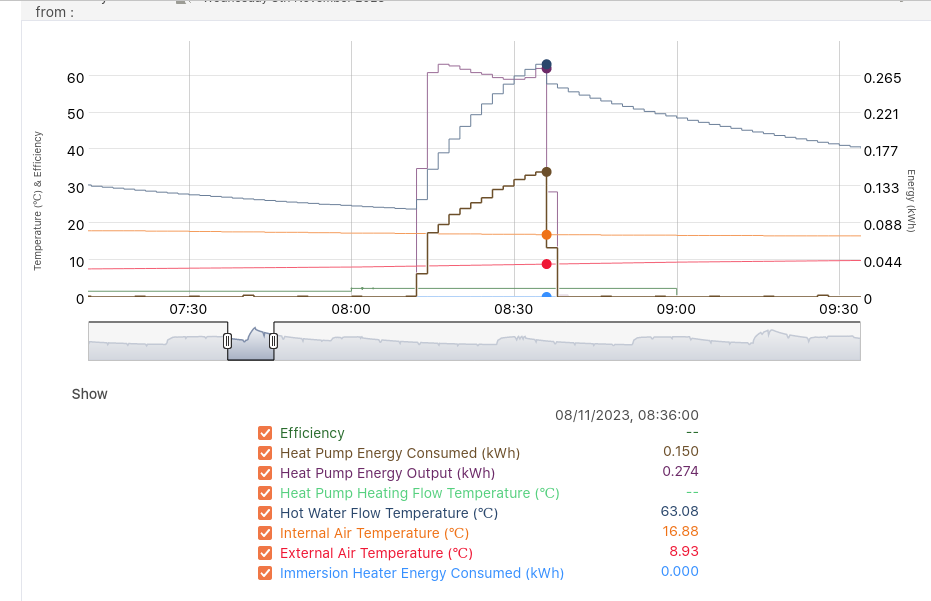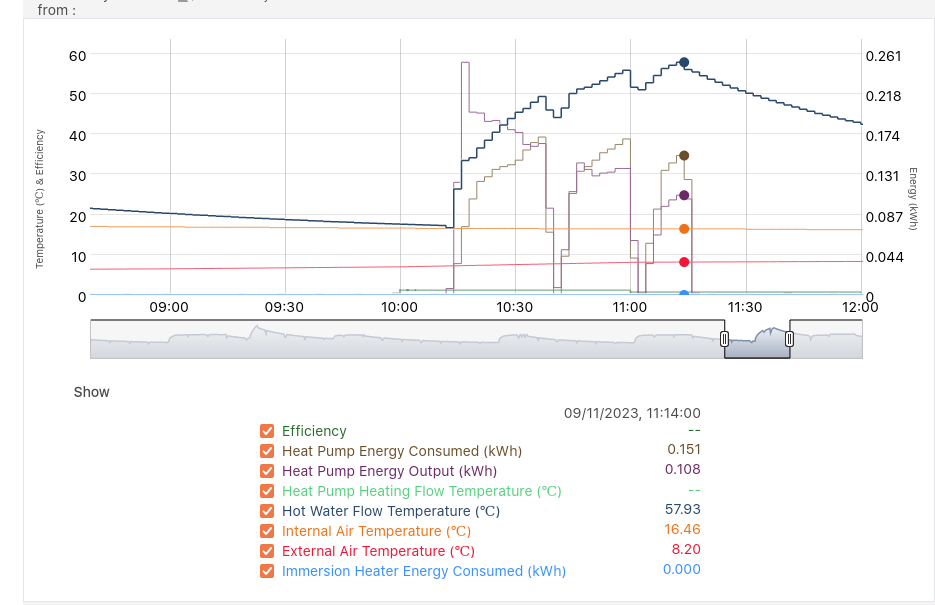
MikeJH
Members-
Posts
12 -
Joined
-
Last visited
Recent Profile Visitors
The recent visitors block is disabled and is not being shown to other users.
MikeJH's Achievements

Member (3/5)
0
Reputation
-
Thanks to all for your advice. It has been very helpful.
-
An elderly friend of mine had her loft space boarded up many years ago with minimal insulation beneath the boards. It is unheated. She would like to improve her house insulation and has been advised to have SuperFOIL SF19+ fitted on the internal side of the roof. The loft space is not air tight and cold air draughts will be entering near the eaves. Consequently, we are unsure whether fitting SuperFOIL SF19+. will have any worthwhile effect on reducing heat loss from the living area of the house. Can anyone advise on the wisdom of proceeding with this form of insulation? SF19 SUPERFOIL | Green Guard
-
New ASHP installation (Samsung monoblock)
MikeJH replied to Erik79's topic in Air Source Heat Pumps (ASHP)
What model Samsung do you have and who are your installers? Hugh is right about avoiding a buffer tank unless your pipe work is particularly small diameter. -
Hi, my 12kW Gen 6 ASHP normally will heat my domestic hot water from 20 deg C to 53 deg C in about 30 minutes and uses around 1.5kWh. Recently, it has been intermittently struggling to do so with the compressor stopping twice during the process and using much more energy. The two figures from PassivLiving illustrate the change in behaviour. On 8th November, the flow temperature rises steadily to 63 deg C. The energy output which is recorded over 2 minute intervals runs at around 0.265 kWh (ie power of nearly 8kW). By contrast, on 9th November, the flow temperature rises more slowly and the energy output after a brief peak drops to the same level as consumption. Both then drop to zero as the compressor stops for a short period. By the end of the process consumption is greater than energy output. The flow rate is 19L/min, which is slightly lower than when space heating (22L/min). I have had no problems with space heating, so I wonder if it is something to do with the DHW cylinder which is a Telford Tempest Heat Pump 170 L tank. I would be very grateful for any advice.
-
Insulating an unused chimney in old stone cottage
MikeJH replied to MikeJH's topic in Heat Insulation
Thanks very much for this advice. It is inside an external 50cm thick, otherwise solid, stone wall, north facing. It is effectively a column of air inside the wall, so option 1 seems to be the best choice, but leaving it unsealed. -
I would be very grateful for any advice about insulating an unused chimney. I have a single storey kitchen, which was presumably added to the original stone cottage at a later date, but is probably over 150 years old. This is the coldest room in winter and there are limited options to improve insulation, the loft being well insulated and the floor being solid. The walls are solid stone and 50 cm thick, but the north facing wall has an unused chimney, now bricked over apart from an air brick. The upper end of the chimney ends in the loft just below the roof (there is no longer any external chimney), so it is ventilated at both ends. I am assuming that the reduced thickness of the wall, where the chimney is increases heat loss. Can anyone advise me of the pros and cons of filling the chimney with material, such as blown glass beads or vermiculite with the aim of reducing heat loss through this wall? Will this work or will it invite damp problems due to lack of ventilation? The roof is being repaired at present, so this is an ideal time to have access to the top of the chimney. Many thanks, Mike
-
LG Therma V mono block Air Source Heat Pump
MikeJH replied to ProDave's topic in Air Source Heat Pumps (ASHP)
Hi Chris, would you be able to explain how you connect to the PassivLiving MMSP set up? I have a Sontex Superstatic 449 Heat meter and a Eastron SDM630-Modbus V2 meter for ASHP power usage. I am trying to read up about Modbus, but my knowledge is very limited. I am used to coding in VB and Transact SQL. My initial problem is understanding how to physically connect my laptop to the PassivLiving set up. Sadly, I'm also clueless about how to access the information after that. Any pointers that you can provide would be greatly appreciated. -
To be fair to Greener Living, this is likely to be a fairly standard Samsung install. Even if Freedom HP is wrong about the warranty, a buffer appears to be recommended as part of installing a Samsung. This was confirmed by another company that serviced it this year. GL has also returned to fit the missing strainer and fix the MMSP monitoring when requested, but there was no real commissioning or attempt to make the system more efficient. The engineers were called to another job before the electrician had even finished! It is only through forums like this, that I have begun to understand how to get the best out of it.
-
Thanks. The advice to install bypass valves came from Brendon Uys, plus remove TRVs and the Honeywell valves and anything else that will reduce flow. My pipework to the radiators is 22mm to 2 kitchen radiators and the upstairs bathroom radiator and then 15mm to 5 other radiators, so I won't be able to get a flow rate much above 20L/min. According to the Samsung wired controller the maximum flow rate is 23L/min in the primary circuit, but the Sontex heat meter gives a value of 15L/min, so this may not be an issue. According to Freedom Heat Pumps, a buffer tank with flow separation is required by the Samsung warranty. This despite its previous owner now saying that buffer tanks should rarely be used. Yes I am, but obviously I have to run 4-5 deg C higher than I would if I had a direct system.
-
Yes, they are all taken from the pipes leading into or from the buffer. I also recorded the flow and return temperatures recorded by the Sontex heat meter and these were virtually identical to the buffer in and buffer return values (the lines on the graph with all values overlap almost completely). There was no cycling during this period. Ambient was around 7 deg C The tanks are installed in an unheated porch. The buffer has internal insulation presumably as it it is not warm to touch on the outside, similar to the DHW cylinder.
-
I have followed the discussion between @JohnMo and @IanR with great interest. I suspect Ian is right if buffer tanks are suitably designed and sized. However, I believe that most are similar to my own 50L buffer tank (see attached photo), installed by a company that claims to install more ASHPs than anyone else. There is a 4-5 deg C temperature drop between the flow from the 12kW Samsung ASHP into the buffer and the flow out of the buffer to the radiator circuit as seen in the attached diagram. This adds around 10-12% to the energy costs of heating for no apparent benefit. When the ASHP cycles in warmer ambient temperatures it cycles every 8-9 minutes, despite the buffer. In fact I believe that the lower heat delivery from the radiators due to their lower temperature means that cycling becomes more likely, not less. When I reduced the setting on the primary water pump from 3 to 1 and increased the setting on the secondary water pump (to the radiators) from 1 to 3, the difference between buffer in and buffer out rose to around 10 deg C and the ASHP started cycling 5-6 mins on and 3-4 mins off. This cycling stopped once the pump settings were restored. I am hoping to have my buffer tank removed and bypass valves installed. Together with the removal of glycol, this might reduce energy costs by 25%. The expected SCOP of 3.68, based on Samsung's datasheet at 50 deg C flow temperature is a complete joke. I can only surmise that Samsung's 'Seasonal' was from June to August, possibly in the Bahamas!



